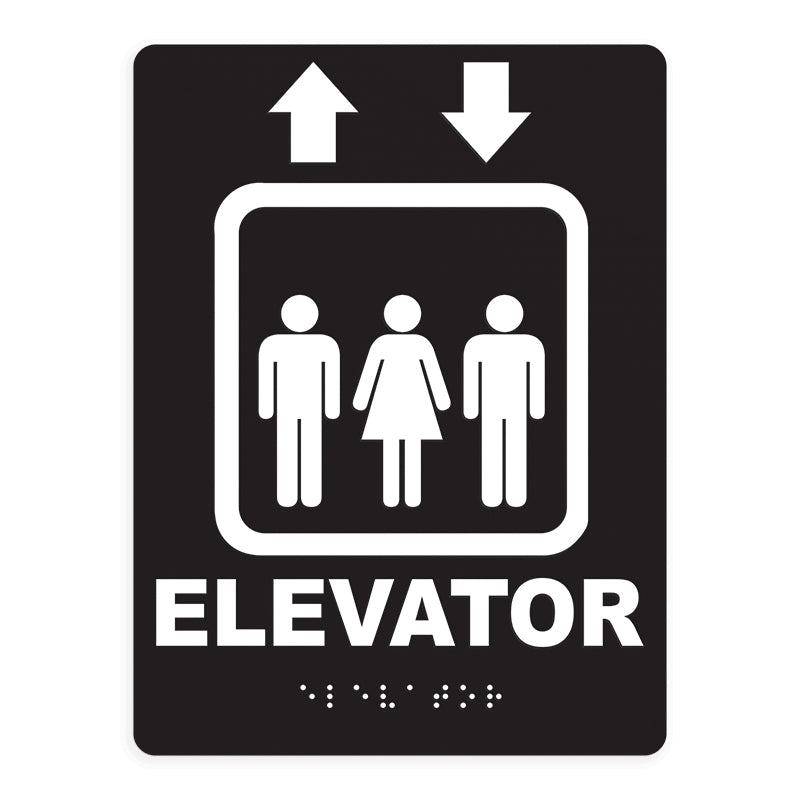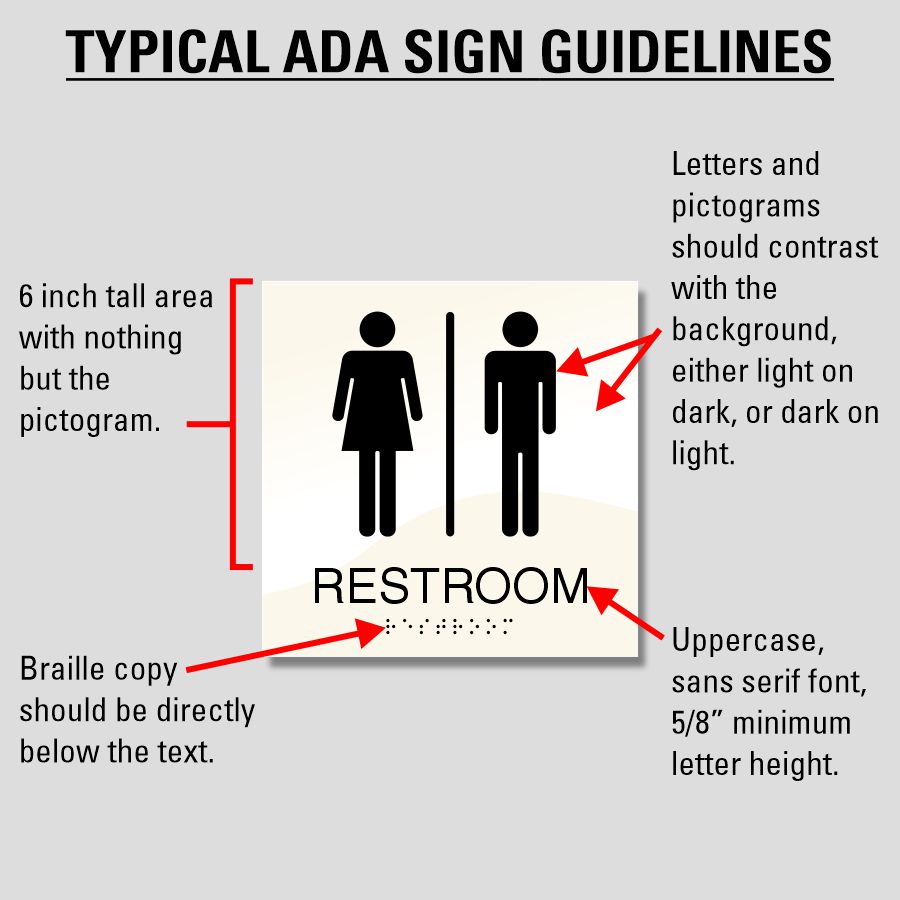ADA Signs: Crucial Tools for Inclusive Environments
ADA Signs: Crucial Tools for Inclusive Environments
Blog Article
Discovering the Key Features of ADA Signs for Improved Accessibility
In the world of accessibility, ADA signs offer as quiet yet effective allies, making certain that spaces are accessible and comprehensive for individuals with disabilities. By integrating Braille and responsive aspects, these indications damage barriers for the visually damaged, while high-contrast color systems and legible fonts cater to varied aesthetic needs.
Significance of ADA Conformity
Making certain conformity with the Americans with Disabilities Act (ADA) is vital for promoting inclusivity and equivalent access in public rooms and work environments. The ADA, established in 1990, mandates that all public facilities, companies, and transportation services accommodate individuals with handicaps, guaranteeing they take pleasure in the same rights and chances as others. Conformity with ADA criteria not just satisfies legal responsibilities but additionally enhances an organization's online reputation by showing its dedication to diversity and inclusivity.
Among the crucial facets of ADA compliance is the execution of easily accessible signs. ADA signs are created to guarantee that individuals with impairments can conveniently navigate via structures and areas. These indicators should follow specific standards concerning dimension, typeface, shade comparison, and positioning to ensure exposure and readability for all. Effectively implemented ADA signs aids eliminate barriers that individuals with impairments often experience, thus advertising their self-reliance and self-confidence (ADA Signs).
Additionally, sticking to ADA guidelines can alleviate the threat of legal consequences and prospective penalties. Organizations that stop working to follow ADA guidelines might encounter charges or claims, which can be both financially challenging and harmful to their public picture. Hence, ADA compliance is important to promoting a fair environment for everybody.
Braille and Tactile Elements
The incorporation of Braille and tactile components right into ADA signage personifies the principles of ease of access and inclusivity. These attributes are vital for individuals that are blind or aesthetically impaired, allowing them to navigate public areas with higher independence and self-confidence. Braille, a tactile writing system, is necessary in offering created details in a layout that can be conveniently perceived through touch. It is typically placed below the matching message on signs to guarantee that people can access the information without aesthetic support.
Responsive components prolong beyond Braille and include raised symbols and characters. These parts are designed to be noticeable by touch, permitting individuals to recognize space numbers, washrooms, exits, and other vital areas. The ADA sets specific guidelines regarding the dimension, spacing, and positioning of these tactile aspects to optimize readability and make sure consistency across various environments.

High-Contrast Color Pattern
High-contrast shade systems play a pivotal function in improving the visibility and readability of ADA signage for individuals with visual problems. These schemes are important as they take full advantage of the difference in light reflectance in between text and background, guaranteeing that indicators are quickly discernible, also from a distance. The Americans with Disabilities Act (ADA) mandates using specific shade contrasts to accommodate those with limited vision, making it a vital element of conformity.
The effectiveness of high-contrast shades depends on their capability to stick out in numerous lights problems, including poorly lit atmospheres and areas with glow. Commonly, dark message on a light history or light text on a dark history is employed to accomplish optimum comparison. For circumstances, black text on a yellow or white history gives a raw visual distinction that assists in quick acknowledgment and understanding.

Legible Fonts and Text Dimension
When considering the layout of ADA signage, the selection of legible typefaces and appropriate message size can not be overstated. These elements are essential for making sure that indicators are available to individuals with visual problems. The Americans with Disabilities Act (ADA) mandates that font styles must be sans-serif and not italic, oblique, script, highly ornamental, or of uncommon form. These needs help make certain that the text is easily readable from a range and that the personalities are distinguishable to diverse target markets.
According to ADA guidelines, the minimal text elevation must be 5/8 inch, and it ought to boost proportionally with checking out range. Uniformity in message dimension adds to a natural visual experience, aiding individuals in browsing environments effectively.
In addition, spacing between lines and letters is important to legibility. Adequate spacing avoids characters from showing up crowded, improving readability. By sticking to these criteria, check over here developers can dramatically improve ease of access, ensuring that signs serves its designated function for all individuals, no matter of their aesthetic capabilities.
Effective Placement Methods
Strategic placement of ADA signage is necessary for making the most of availability and making sure conformity with legal standards. Properly positioned indicators guide people with impairments successfully, assisting in navigation in public areas. Trick considerations consist of proximity, elevation, and exposure. read the full info here ADA guidelines specify that indications should be installed at a height in between 48 to 60 inches from the ground to ensure they are within the line of sight for both standing and seated people. This basic height range is critical for inclusivity, making it possible for wheelchair individuals and individuals of varying elevations to access details easily.
Furthermore, indications should be placed beside the lock side of doors to enable very easy recognition prior to access. This placement helps individuals situate spaces and spaces without obstruction. In situations where there is no door, indications should be located on the local surrounding wall surface. Uniformity in indicator positioning throughout a facility enhances predictability, minimizing confusion and improving general individual experience.

Final Thought
ADA signs play an important function in advertising availability by incorporating attributes that address the requirements of individuals with handicaps. These aspects collectively cultivate a comprehensive atmosphere, underscoring the value of ADA compliance in making certain equivalent gain access to for all.
In the realm of access, ADA signs offer as silent yet effective allies, ensuring that rooms are inclusive and accessible for people with handicaps. The ADA, passed in 1990, mandates that all public facilities, employers, and transportation services suit people with specials needs, guaranteeing they delight in the exact same legal rights and possibilities as others. ADA Signs. ADA signs are designed to ensure that people with specials needs can easily navigate with spaces and buildings. ADA guidelines stipulate that indications ought to be mounted at an elevation in between 48 to 60 inches from the ground to ensure they are within the line of sight for both standing and seated people.ADA indications play a crucial role over at this website in advertising accessibility by integrating attributes that resolve the requirements of people with specials needs
Report this page